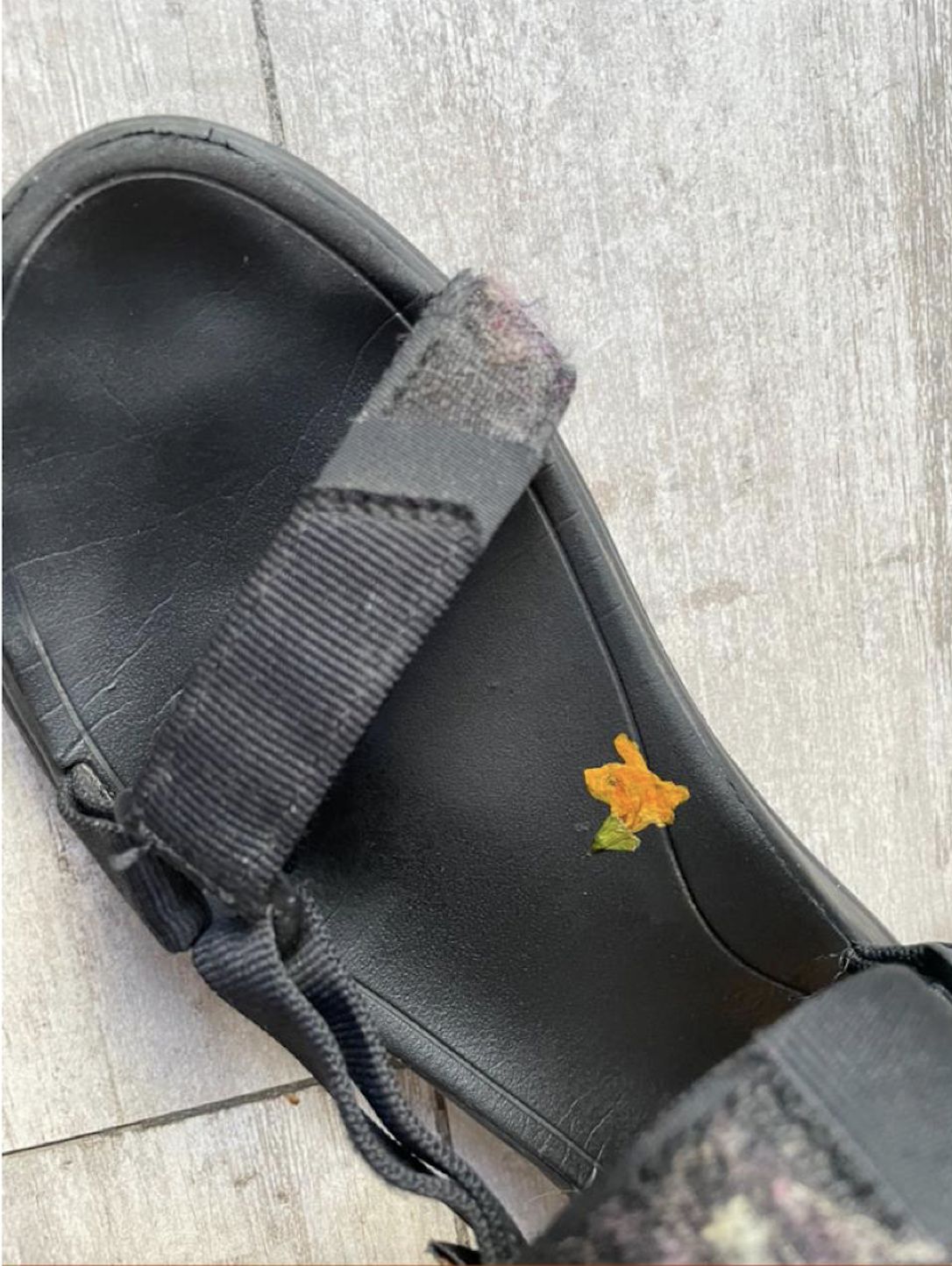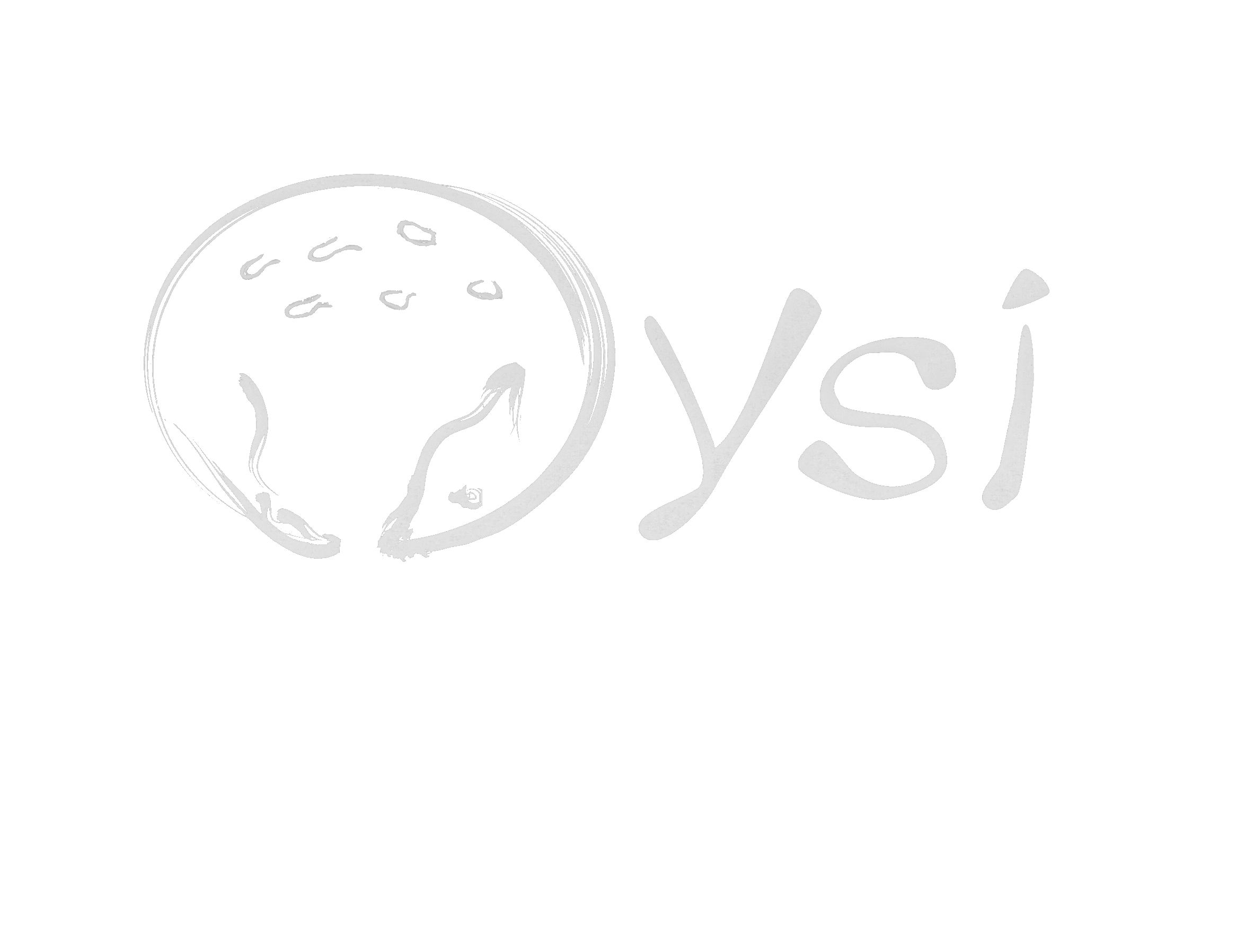GOLDEN FLOWER OF THE TIPA TREE
Posted by studio@ceciliavicuna.com on January 11, 2024 in
GOLDEN FLOWER OF THE TIPA TREE

The little golden flower of the tipa tree pressed against my sandal.i
Buenos Aires, December 2023
Cecilia Vicuña: Yesterday, my mother and I spent a long time in a little park, under tipa trees that may be more than 200 years old. They have these tiny golden flowers. And these flowers were raining, raining on us a rain of flowers. I could see that the people in the park didn't see the rain of flowers. But the rain of flowers kept coming, coming, coming. I was in awe of the beauty that we were being gifted just by quietly lying down in the park. And in the evening when I came home and removed my sandal, I saw that one of the flowers had gotten between my foot and the sandal. How did the flower get there? Impressed as glued to the sandal. And I thought: what a wonderful little gift.
James O'Hern: Yes, a beautiful gift, connecting to another dimension of meaning outside space and time. Like in the Ray Bradbury story, The Sound of Thunderii, where a time-travel hunter returns to earth from a safari in the Late Cretaceous past and notices subtle changes everywhere. "Looking at the mud on his boots, Eckels [the hunter] finds a crushed golden butterfly, whose death has apparently changed the nature of the alternative present..." such moments feel like time-travel. I remember as a boy the creation of boundless space with my horse Albert when we lay down on a caliche cliff above the Rio Grande and the desert below came alive with stories from another time: Indians battling as one with their horses, mica chips flashing signals in the caliche hills, and Monte Alban gleaming white 800 miles south in Oaxaca.
When Albert died, I was feeling a strong ESP communication with him as we were co-dreaming together, so I know he felt I was loving him. He knew I could see the courage of his ancestors, so he could feel his horse pride, his pride about where he came from.
CV: I love this idea of the wholeness, seeing the other as a lineage in front of our eyes.
Joh: In the West the aliveness of the lineage is an unexpressed dimension, but in traditional cultures the vibratory interaction between the fields is ever present.
CV: Yes, I agree. I feel the animals and the babies in all cultures pick up the qualities of the vibratory interaction. In New York, babies read, sense my state of mind as I walk down the street communicating with the birds, the light, and the trees. This quality of delight and appreciation is fulfilling to them. Joy completes them because they long for it. Even the flowers respond. Everything responds.
Joh: Like the vibratory communication you have with the sea. This should be part of our legacy so that this is known.
CV: Yes, I have written many times the story of how the sea showed me the way at the very start of my life. There's a film my parents made in l949 where a one-year-old Cecilia is knocked down by the waves. She is stunned for a second and then smiles in wild delight and goes for more.
Joh: The feeling of being connected in non-conceptual, non-verbal ways that Albert brought up for me is an opening to what is outside the cognitive: the immortality of our connectedness in the creation of meaning.
CV: Deep communication outside time and space may be the true function of poetry and art. I think Albert understood your message because you expressed it as poetry, in vibratory terms. You became a poet by learning to communicate with him. Human language is a huge mystery in that the non-conceptual, non-verbal exists within the verbal. Before forming, words dwell in the "not yet", "about to happen" potential from which meaning emerges. This atemporal dimension within words, its porous fluidity animates language. Long ago I wrote: Dialogar con lo que no es palabra al interior de las palabras crea la unión. (To converse with what is not word inside words creates union.)iii
Joh: In the act of conversing with Albert, words took on a vibratory quality that included the sounds of everything in the desert. Coming alive, our togetherness brought a shared 360o peripheral awareness of the sounds reverberating with the words that could see and hear a snake approaching from behind.
CV: Did you think in words or concepts?
Joh: If I thought of a word, I didn't need to say it aloud. At the end of his life, Steven Hawking's principal collaborator communicated with him via an ESP where words and concepts were exchanged even without vocal expression.
CV: Another instance of this kind of collaboration is noted by epigraphers studying certain writing systems, such as the Maya script, where the words and concepts were inscribed to implicate the reader in a co-creation, to “place the viewer in the role of a seer.”iv
In a sense the immortality of our connection in the creation of meaning is that it includes us all. It is immortal because it is collective. The depth and mystery of the individual is only possible because it is part of a universe. That's why the oral matters, as you have said so many times; the "oral" is the true repository of our common knowledge.
In the long run, immortality has an ethical dimension, an orientation that forwards life and balance, permanence within impermanence.
In quantum theory, they say that given all possible outcomes, somehow 'truth' prevails.
'Truth' being the goodness and continuity of it all---- and this rule applies from the start: particle and antiparticle clash and destroy each other but one survives. This beautiful paradox makes us.
Joh: Tracking the evolution of meaning beneath the surface allows it to evolve.
CV: The original meaning of the word 'meaning' is 'intent'. I often think of this wonderful image in the Popol Vuh translated and interpreted by Dennis Tedlock: the ancient Maya sages said that when the Gods created humans, their sole purpose was to hear poetry. In other words, they wanted to hear meaning created musically. This meaning had to be beautiful, otherwise the Gods would strike humanity as a failed experiment. The ethos transmitted by the Maya is the beauty of connection, of relation. A palpable, immaterial beauty.
Joh: At the end of Albert's time, I made a blood oath to never betray the truth of our love.
When I shot my beloved
I hugged him heartbroken,
took off my boots
filled them with the blood
that poured from his nose.
I walked back to the ranch
with my boots sloshing wet
and slept with my socks
soaked in his blood -
Albert Poem by James O'Hern
CV: You told me that with Albert's death, your connection with him created the field of awareness of who you were, (the mutual you, not just you), that his death confirmed your experience, at age seven shooting a 'sacred' peyote-deer that invited you to kneel at his side as he died.
Joh: These deaths began to make more sense when I came across the "Trance the Kalahari"vi where the San shaman and the sacred eland die at the same time. The San call it !gi. The exclamation point as the instant when "superpotency" is transmitted by the animal to the hunter.
CV: Superpotency as wisdom rising from honoring the gift. The foundation of who you are began with your oath to Albert on his death. I made a similar pledge to the sea in the 60's in Con con when I understood that the Sun and the Sea could "see" me. Feeling their awareness, I dissolved into the ocean of consciousness. This was the beginning of my life as your communion with Albert on his death was the beginning of your life.
Death is the precondition for immortality, only through death we understand and see with nonphysical eyes who we are.
Joh: This is crucial to develop a virtual framework for the channel of evolution that relates these experiences to the metamorphosis of the butterfly, from caterpillar to butterfly to super-butterfly. It is about the imaginal cells in their full potential moving from formless to form.
CV: And back to formless through dissolution.
Joh: I made a pledge to Albert not knowing that it was a pledge to hold on to what we had created with each other. I mean the magic of that extraordinary creativity of soul to soul in that state. As a child I had this one notable experience being with him on a cliff overlooking the Rio Grande looking south over the desert while talking about the courage of his ancestral heritage. Here's an abused horse that's never been wanted, and we are together recalling the extraordinary way the Indians fought their battles, slinging themselves down fused along the body of the horse. And the horses operated together attacking the enemy. It was the mind of the horse, the courage of the horse that guided the battle. Communicating how proud I was of him and his heritage in our ESP way he felt it and for that short period it put us into that space where I could see Monte Alban 800 miles to the south. Then when my parents and I visited the ruins some years later, they fit right into the memory of that image I had with Albert. So, it verified the vision was not just a child's imagination. It was a co-created reality between me and Albert. And that is the bedrock for future discussion.
CV: Your description made total sense to me since it allowed me to understand the 15 Flower World Variations: A Sequence of Songs from the Yaqui Deer Dancevii I had translated in l985 in a different way.
Joh: That was the way they lived their daily existence, and that magic has not been erased from all memory, but you can't put it into words.
CV: Yes, describing the Yaqui deer dance always falls short, limiting or "censoring" its meaning.
Joh: The dialectic of Western words needing a subject-object type thing can't describe the experience of being in unified space with the entire universe. Integrating our experience at that level of unity means trying to develop a vocabulary, a way of speaking about it encompassing everything beyond words.
i Trialog recorded while James O’Hern was in New York and Cecilia Vicuña was in Buenos Aires, Argentina, for her exhibition Cecilia Vicuña, Soñar el agua, at MALBA Museum
ii https://en.wikipedia.org/wiki/A_Sound_of_Thunder
iii Instan, Cecilia Vicuña, Kelsey Street Press, Berkeley, CA 2002
iv 2000 Years of Mayan Literature, Dennis Tedlock, University of California Press, 2010 p. 42
v https://oysi.org/pics/Albert_%28Spanish_and_English%29_3.pdf
vi Shaman Healing Dance https://www.bradshawfoundation.com/south_africa/san_rock_art/index.php
vii https://www.abebooks.com/Flower-World-Variations-Sequence-Songs-Yaqui/30789316322/bd

